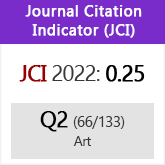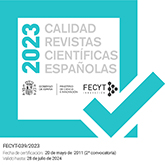La representación de Gog y Magog y la imagen del Anticristo en las cartas náuticas bajomedievales
DOI:
https://doi.org/10.3989/aearte.2005.v78.i311.181Keywords:
Antichrist, False Prophet, Gog and Magog, Catalan Atlas, Mallorcan School of Cartography, Chart of Juan de la Cosa, Jean de Mandeville, Anglo-Norman Apocalypse, Hortus Deliciarum, Herrad de HohenbergAbstract
The legend of the enclosure of Gog and Magog by Alexander the Great had important repercussions during the Middle Ages. It constituted part of the geographical concepts of the period and was materialized in cartography. Due to the evolution that the legend underwent over the centuries, the Antichrist came to form part of it. In this article the author analyzes one of the problematic images from the Catalan Atlas, until now considered by some scholars to be a representation of God in Paradise. Here it is interpreted as being the Antichrist as false prophet performing miracles. This image endured for a long time within the Mallorcan School of Cartography in works associated with the same workshop and area of influence. A result of the influence of the Mallorcan charts on the Sevillian School of Cartography is the presence of this image in the Chart of Juan de la Cosa.
Downloads
Download data is not yet available.
Downloads
Published
2005-09-30
How to Cite
Sáenz-López Pérez, S. (2005). La representación de Gog y Magog y la imagen del Anticristo en las cartas náuticas bajomedievales. Archivo Español De Arte, 78(311), 263–276. https://doi.org/10.3989/aearte.2005.v78.i311.181
Issue
Section
Articles
License
Copyright (c) 2005 Consejo Superior de Investigaciones Científicas (CSIC)

This work is licensed under a Creative Commons Attribution 4.0 International License.
© CSIC. Manuscripts published in both the printed and online versions of this Journal are the property of Consejo Superior de Investigaciones Científicas, and quoting this source is a requirement for any partial or full reproduction.All contents of this electronic edition, except where otherwise noted, are distributed under a “Creative Commons Attribution 4.0 International” (CC BY 4.0) License. You may read here the basic information and the legal text of the license. The indication of the CC BY 4.0 License must be expressly stated in this way when necessary.
Self-archiving in repositories, personal webpages or similar, of any version other than the published by the Editor, is not allowed.















